Writing an essay or article? Study these headings and subheadings examples to make your own even more effective.
Headlines are an important part of writing. The right headings and subheadings draw the reader in and get them excited about the rest of the piece. Yet, writing subheadings and headings is not always easy. Different types of headings carry a different meaning in the piece, and different writing guides require different formatting.
In this guide, you’ll find great subheading examples and learn how to create headings and subheadings that make your writing shine. While you’re here, check out our round-up of essential essay writing skills!
Contents
What Are Headings and Subheadings?

Headings and subheadings are the lines that outline the piece you’re writing. The heading is also known as the title or header. It tells the main idea of the piece.
Subheadings open the different subsections of the piece or sections of the paper. Writers use headings to break up large chunks of text into more easily read pieces. Subheading examples can help you visualize how headings will work in your piece of writing.
Why Headings and Subheadings Matter
For academic papers, headings provide the reader with a clear outline of the piece. They serve as section labels, pointing the reader to the main ideas. If the reader does not read every word, they can still come away with the basic idea of the paper.
For web-based writing, headings and subheadings have an even more important role. Not only do they keep the reader engaged, but they also provide the search engines with a road map of what the page is about. This perk can help draw search engine traffic to the page.
Writing an Effective Heading
To write an effective heading, you must figure out what you want the main idea of your piece to be. Then, you will need to craft a heading that captures the reader’s attention from the very first word. Reading subheading examples is a great way to study and refine this writing.
To make a heading or title effective, set it apart from the body text. You can use H1 formatting in Word or Google Docs to do this.
Then, use one of these best practices to create an effective piece:
- Create a controversy
- Keep it short
- Ask a question
- Offer a number
- Offer an explanation
Examples of Great Headings
Here are examples of good headings:
- Do You Ever Make These Marketing Mistakes?
- 7 Strategies to Get Readers Every Time
- Tactics Marketers Don’t Want You to Know
- The Shocking Secret to Relieving Workplace Stress
How to Write Great Subheadings

Subheadings are another type of heading, and they do more than grab attention. Subheadings help you keep the reader engaged on the page by guiding them to the information they want.
Subheadings typically fall into three categories. Here is how these break down:
- H2: The first level of subheading, the H2s are your main outline points or the header for each main section of your piece.
- H3: These are the subsections of the main H2 points.
- H4: The H4 headings are detailed subheadings that break the content down into more specific sections.
Examples of Subheadings
Here are some examples of subheadings that work quite well:
- Give Your Readers More Information
- Use This Product to Tighten Loose Skin
- Effective Subheads Keep Readers Engaged
In addition, your subheadings can be even more simple, just a numbered list of what you are talking about in the piece.
Formatting Headings
To format your headings, you must check the publication manual assigned to the paper or publication. If you are doing this for school, you may also get a sample paper to study.
For APA format papers and works, use these formatting rules:
- Level 1 Headers (H1 or paper title): Centered on the page, boldface, title case, and the new paragraph text begins on a new line with indentation
- Level 2 Headers (H2): Flush left, boldface, title case, and the text begins on a new line with indentation
- Level 3 headers (H3): Flush left, boldface, italic, title case, and the text begins on a new line with indentation.
- Level 4 Header (H4): Indented, boldface, title case, period, and the text begins on the same line.
- Level 5 Header (H5): Indented, boldface, title case, italics, period, and the text begins on the same line.
For MLA format, you will use the following structure:
- Level 1 Header (H1 or paper title): Boldface, flush left
- Level 2 Header (H2): Italicized, flush left
- Level 3 Header (H3): Boldface, centered on the page
- Level 4 Header (H4): Italicized, centered on the page
- Level 5 Header (H5): Underlined, flush left
If you are not using MLA or APA headings, you may simply use the template of the piece you are writing. In Microsoft Word and Google Docs, you can format subheadings as H2, H3 and H4.
Subheading Best Practices
When writing subheadings, there are some strategies you can use to make them more effective and engaging. These best practices will make your work cohesive and engaging.
Use Parallel Structure
Consider keeping your subheadings parallel in structure. For example, you can start each one with an action verb, such as these subheadings that would work well for an article about selling a home:
- Get Ready for Your Open House
- Invite Guests to See the Property
- Close the Sale on Your Home
Connect to Your Title
Make sure every subheading in your piece has a connection to either the main heading or the subheading that is the next level up. You will confuse your readers if you change the focus of the piece partway through.
So, for a piece that is titled “10 Best Ways to Entertain a Cat,” each subheading would be a way to do so, such as:
1. Use Toys that Dispense Food
2. Schedule Playtime Daily
3. Vary the Toys You Use
Be Succinct
Lengthy subheadings rarely work well. Keep them short and sweet. This will draw in the reader and keep the piece moving, without creating wordiness.
This example is too long:
- 10 Best Practices to Create Headings That Readers Will Click and Read Through the End
You could say the same thing in fewer words, like this:
- 10 Proven Strategies for Headlines that Convert
Think of Subsection Headings as a Table of Contents
If you’re having trouble figuring out the correct use of headings, consider thinking of them as an outline or table of contents. Break down the main ideas in your piece, and then use those ideas to show organization through headers.
A Final Word on Headings and Subheadings Examples
Headings and subheadings are powerful tools to get people to read what you have written, but you must use them well. They should be short, to the point, and cohesive with one another. Learning to write effective headings and subheadings is best done through studying examples of these.
The more practice you get with writing headings and subheadings that are in line with these examples, the easier it will be to craft them effectively. Study the examples, then start writing, and soon you will be an expert at crafting effective subheads and titles.
FAQs on Headings and Subheadings Examples
What are headings and subheadings?
Headings and subheadings serve as the structure of a written piece. They show the main points and guide the reader through the content.
How to use headings and subheadings?
The proper use of headings and subheadings involves crafting the article around these titles and sub-points. They serve as the structure or the “bones” of the piece, giving it the basics that you fill in with the rest of your content.